LANGUAGES
Specially-Designed Toyota “Tokyo 2020 Version” e-Palette to Provide Automated Mobility to Athletes
- Up to 20 of the e-Palette vehicles to support athlete movement at Tokyo 2020
- Offers Low-Speed SAE Level 4 Automated Transportation throughout the Paralympic and Olympic villages
- e-Palette Vehicle on display from October 24 to November 4 at 2019 Tokyo Motor Show
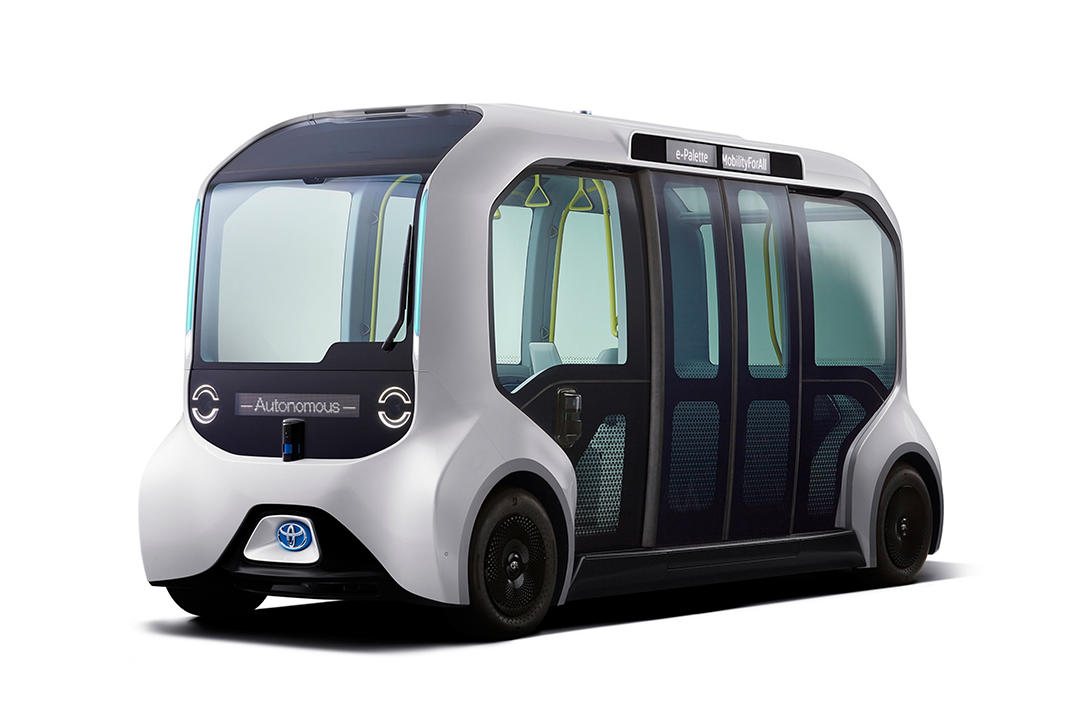
TORONTO – October 9, 2019 ―Toyota announced today that it will supply up to 20 specially-designed “Tokyo 2020 Version” e-Palette vehicles to support athlete mobility at the Paralympic and Olympic Games Tokyo 2020, where it will provide automated, loop-line transportation in the Paralympic and Olympic villages for athletes and related staff. The battery-electric, automated vehicles have been adapted specifically for use during the Paralympic and Olympic Games based in part on feedback from athletes about their mobility needs in the past games.
“Paralympic and Olympic athletes work tirelessly to achieve the impossible, and we wanted to provide them with a vehicle specifically designed and calibrated to fit their mobility needs during Tokyo 2020,” said Takahiro Muta, development leader for the unique version of the e-Palette for Tokyo 2020. “Throughout the development process, athletes, especially Para Athletes, helped us to better understand how we could adapt and upgrade the e-Palette to better meet the need for simple, convenient and comfortable mobility. We are proud to work with them on a vehicle that will not just move athletes physically throughout the Paralympic and Olympic Village but will also offer them new opportunities to interact with others, share new experiences, and be moved emotionally.”
First announced in 2018, e-Palette is Toyota’s first vehicle developed specifically for autonomous mobility as a service (“Autono-MaaS1”) applications. It reflects Toyota’s ongoing transition to a mobility company and combines electrification, connected networks, and advanced driving technologies to support new shared mobility businesses and business models.
The “Tokyo 2020 Version” e-Palette has been adapted to meet the unique needs of the Paralympic and Olympic Village, featuring large doors and electric ramps to allow groups of athletes, including Para athletes, to board quickly and easily. The vehicle will be controlled by an automated driving system capable of operating up to 20 kilometres per hour at SAE level2 4, supported by an on-board safety operator.
Deploying the e-Palette to support athlete and staff mobility is a key element of Toyota’s program to provide advanced mobility solutions for Tokyo 2020 as the first worldwide mobility partner of the Paralympic and Olympic Games. In addition, Toyota plans to leverage the knowledge gained from operating e-Palette at Tokyo 2020 to continue developing the vehicle to support future Mobility-as-a-Service applications. The Tokyo 2020 Version will be revealed and exhibited at Toyota’s booth during the 2019 Tokyo Motor Show3 held in Japan from October 23 to November 4, 2019.
Overview of the e-Palette “Tokyo 2020 Version”
Designed for comfortable mobility
- Designed with front/rear symmetry, a distinctive cube shape, and wheels at the four corners, the vehicle offers expansive and comfortable interior space.
- Reflecting Toyota’s commitment to providing “Mobility for All,” it includes handrails and seats that are easy to use regardless of height; the vehicle also features floor, trim, seats, and other components with color contrasts that assist people with colour-blindness.
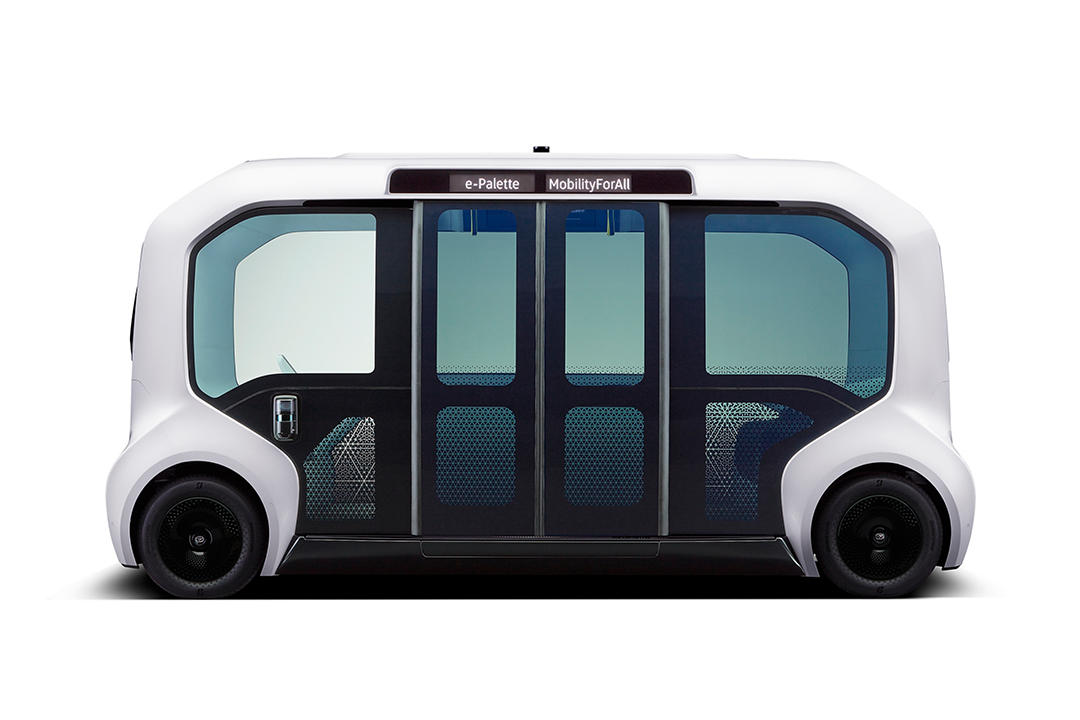
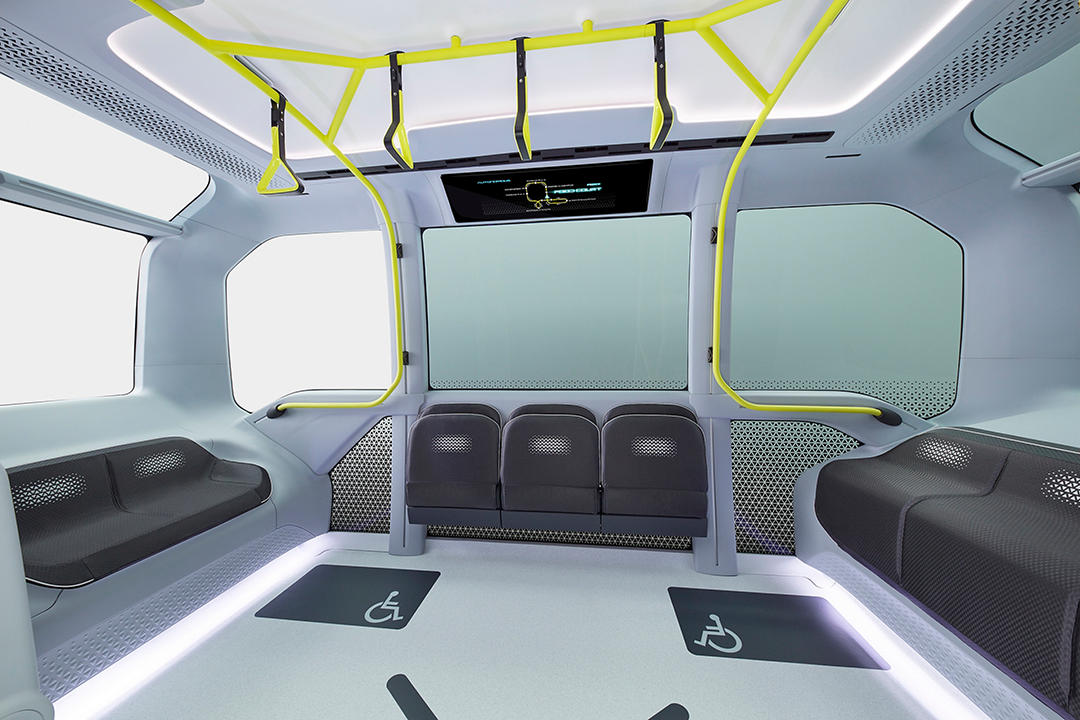
Enabling quick and easy entry/exit for passengers
- The e-Palette is equipped with large sliding doors, low floors, electric ramps, and an Arrival Control4 system for use when approaching destinations to enable passengers, including those in wheelchairs, to enter and exit quickly and easily.
- With its long wheelbase and flat floor, the vehicle can transport up to four passengers in wheelchairs along with additional standing passengers at one time.
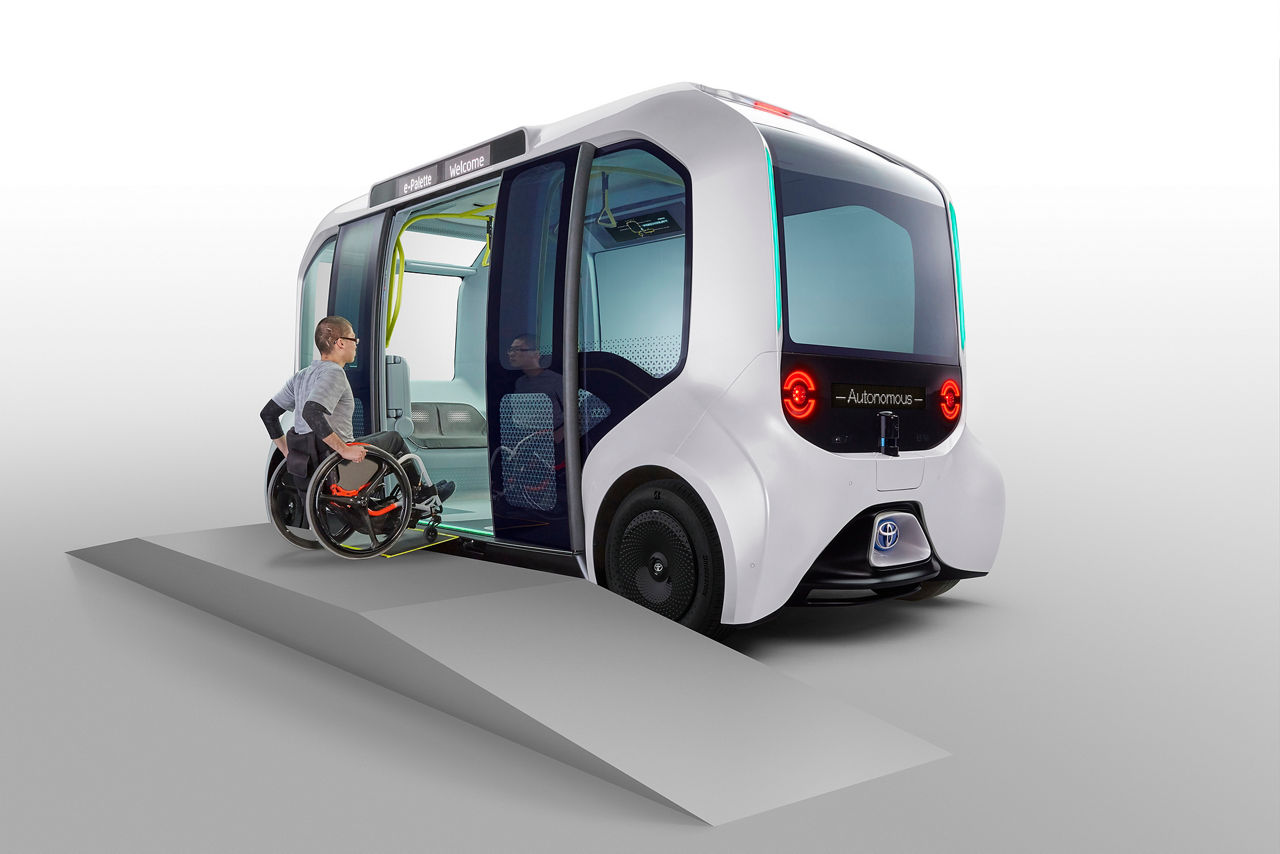
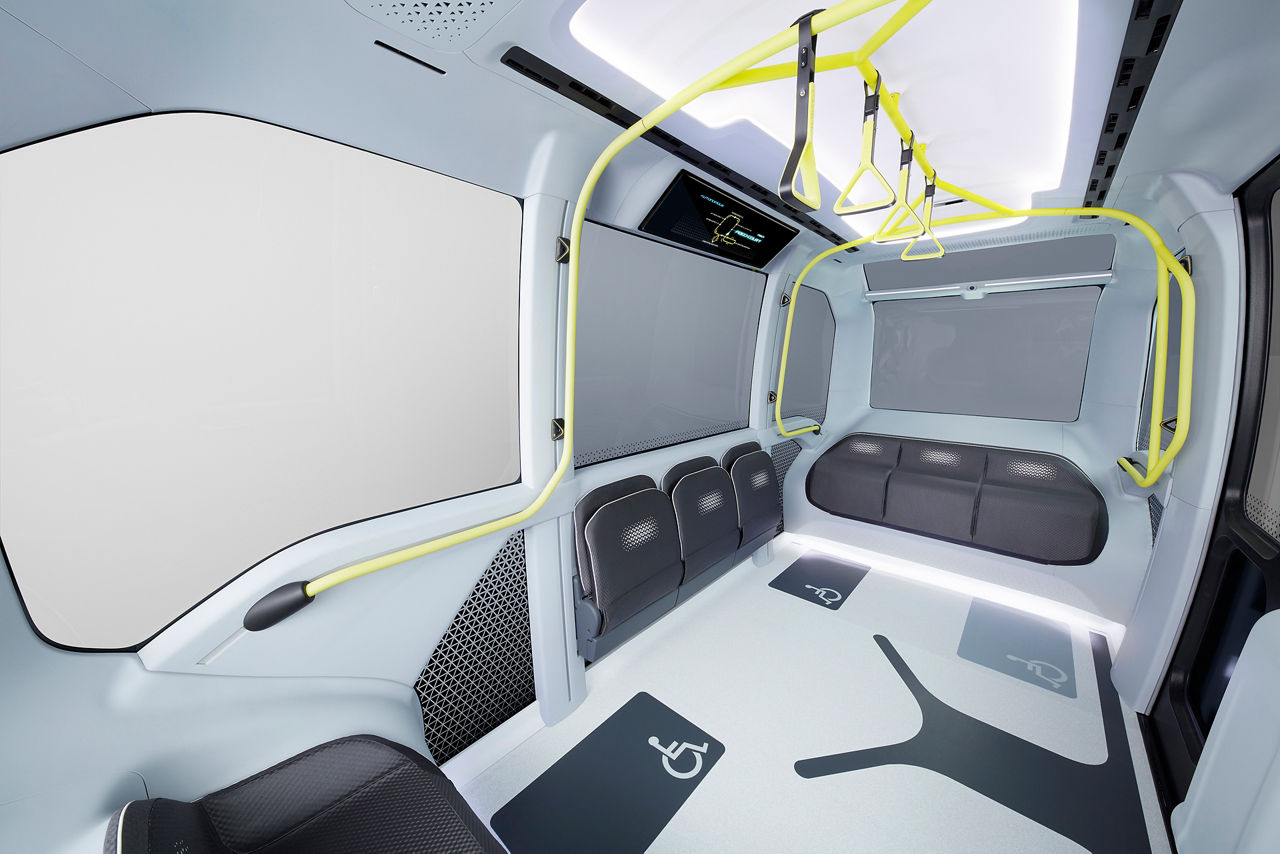
Low-speed automated driving with a focus on safety
- The e-Palette is equipped with a specially-designed automated driving system that includes control hardware, software, and advanced sensors such as cameras and LiDAR. Combined with high-accuracy 3D mapping and an operation management system, e-Palette will realize low-speed automated driving at SAE level 4.
- To support safe operation, the e-Palette features an external human-machine interface designed to assist communication with those around the vehicle, including pedestrians, during automated driving. Headlamps on the front and rear of the vehicle mimic eye contact to inform pedestrians of vehicle actions.
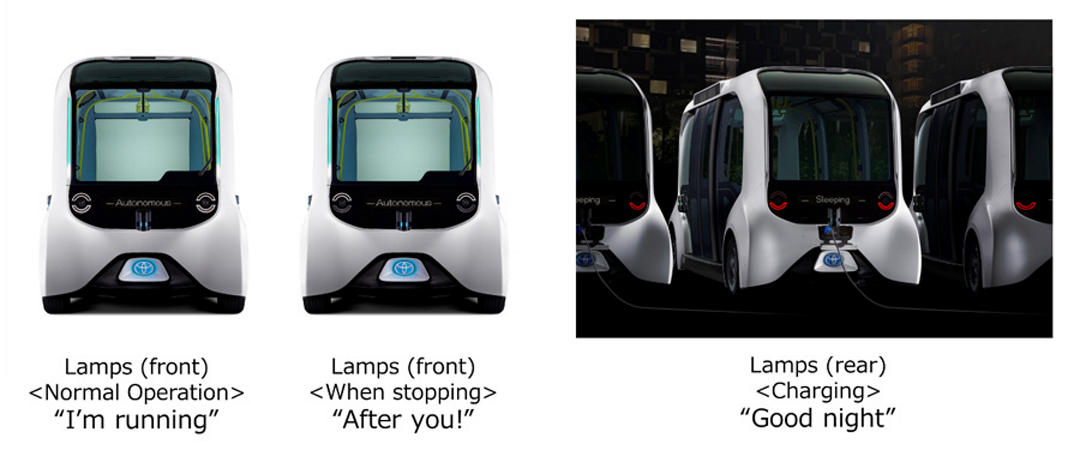
- The automated driving system constantly monitors for obstacles across a full 360-degree field of vision around the vehicle and operates at a speed appropriate and in accordance with the surrounding environment. As a preventative measure, an on-board safety operator will also monitor the vehicle’s movement and be prepared to take control if necessary.
Main Specifications
Length/Width/Height/Wheelbase |
5,255 mm/2,065 mm/2,760 mm/4,000 mm |
|---|
No. of passengers |
Up to 20* (including one operator) *For wheelchairs: Up to 4 wheelchair + 7 standing passengers |
|---|
Range |
Approx. 150 km |
|---|
*1 Combination of "autonomous" and "mobility as a service" describing Toyota's mobility services using automated driving vehicles.
*2 SAE Level references can be found here
*3 The special invitation days is on October 24; the show is open to the general public from October 25 to November 4
*4 It controls the vehicle to stop at the designated boarding and alighting location and minimizing the gap to the bus stop itself.
About Toyota Canada Inc.
Toyota Canada Inc. (TCI) is the exclusive Canadian distributor of Toyota and Lexus vehicles. Toyota has sold over eight million vehicles in Canada through a national network of 287 Toyota and Lexus dealerships. Toyota is dedicated to bringing safety, quality, dependability and reliability to the vehicles Canadians drive and the service they receive. TCI’s head office is located in Toronto, with regional offices in Vancouver, Calgary, Montreal and Halifax, and parts distribution centres in Toronto and Vancouver. Toyota operates two manufacturing facilities in Canada. Having produced more than eight million vehicles, popular Canadian models built at these facilities include Toyota RAV4, Toyota RAV4 Hybrid, Lexus RX 350 and RX 450h hybrid. Recent investments at its facilities in Ontario will allow for increased production of the top-selling Toyota RAV4 and RAV4 Hybrid models.
###
Every effort has been made to ensure the product specifications, equipment, and content on this site are accurate based on information available at time of publishing. In some cases, certain changes in standard equipment or options may occur, which may not be reflected online. Toyota Canada reserves the rights to make these changes without notice or obligation.